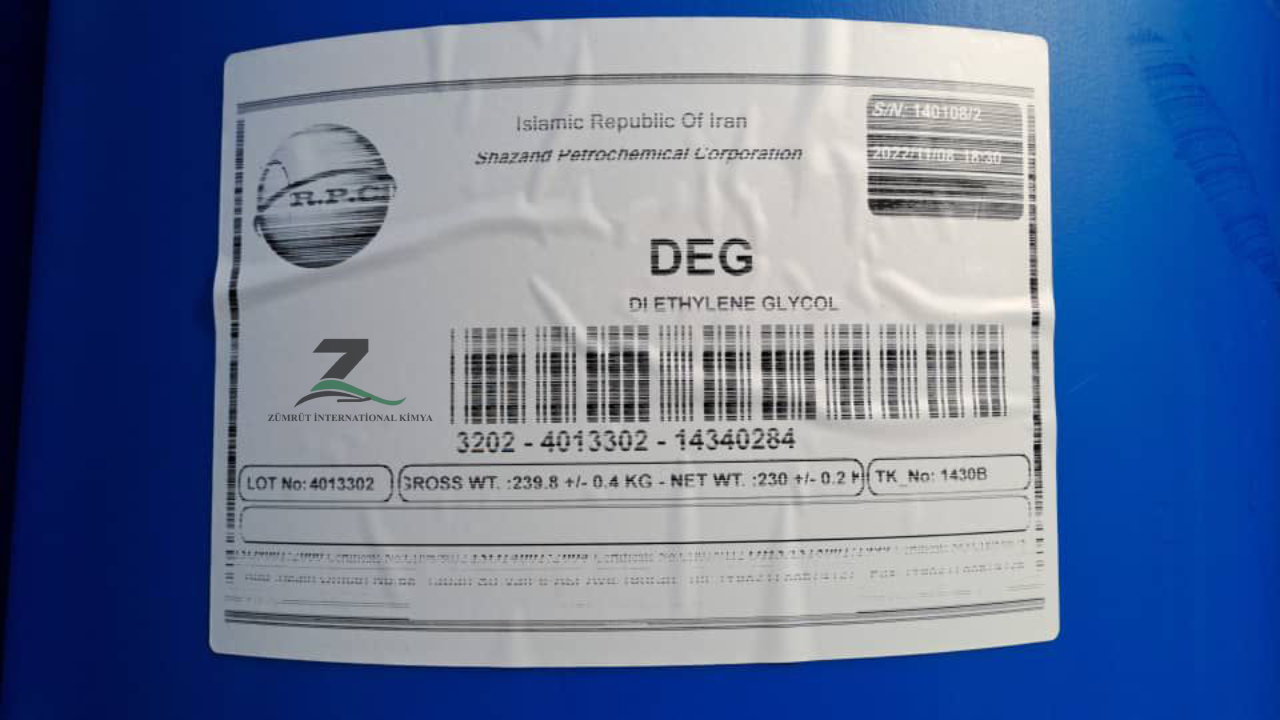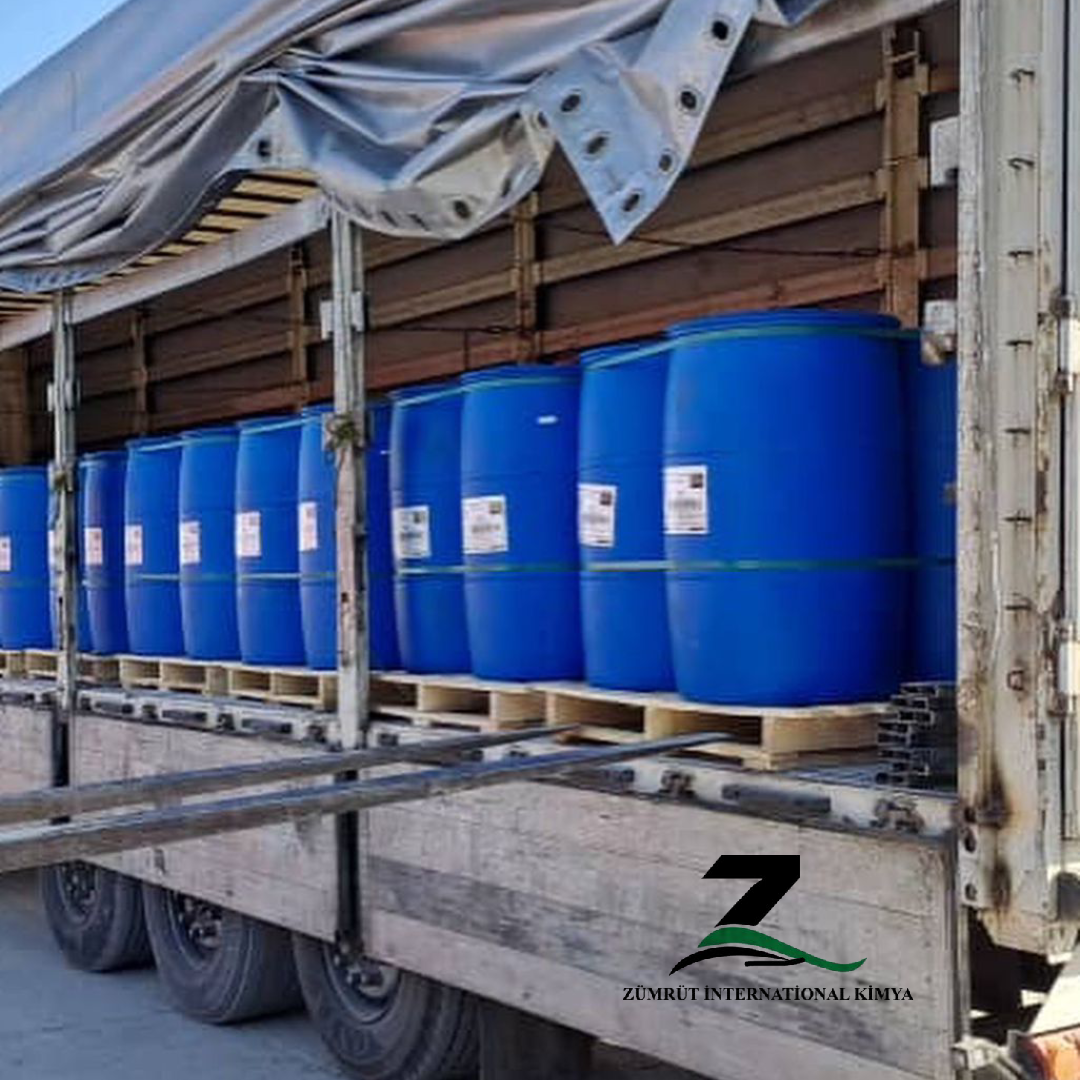
Definition of Diethylene Glycol (DEG)
Diethylene Glycol (DEG) is a colorless, odorless, and hygroscopic organic compound with the chemical formula C₄H₁₀O₃. It is a type of diol (a chemical compound containing two hydroxyl groups), which is derived from ethylene glycol. DEG is soluble in water, alcohol, and other organic solvents and is commonly used as a solvent, humectant, and chemical intermediate.
Diethylene glycol, CH2OHCH2OCH2CH2OH, is similar in properties to MEG (mono ethylene glycol), but DEG has a higher boiling point, viscosity, and specific gravity.
Diethylene Glycol (DEG) is used in the manufacture of unsaturated polyester resins, polyurethanes and plasticizers. It is a water-soluble liquid; boiling point 245 C, and is soluble in many organic solvents.
DEG is produced by the partial hydrolysis of ethylene oxide.
Depending on the conditions, varying amounts of DEG and related glycols are produced. The resulting product is two ethylene glycol molecules joined by an ether bond, Diethylene glycol is derived as a co-product with ethylene glycol and triethylene glycol.
Diethylene glycol, commonly referred to as DEG, is similar in properties to ethylene glycol, but with a higher boiling point, viscosity and specific gravity.
DEG is straight-chain dihydric alcohol which is aliphatic terminated on both ends by a hydroxyl group.
It is a clear, water-white, practically odorless, hygroscopic liquid at room temperature. It is also soluble in many organic solvents.
Diethylene glycol is used as a dehydrating agent for natural gas, a raw material for the production of plasticizers and polyester resin, and a widely used solvent.
It is also used as a humectant in the tobacco industry and in the treatment of corks, glue, paper and cellophane as well as in the synthesis of morpholine and 1,4-dioxane.
Availability of DEG depends on the demand for derivatives of the primary product, ethylene glycol, rather than on DEG market requirements.
Di Ethelene Glycol (also known as DEG, oxydiethanol, and glycol ether glycol) is a clear, colorless, odourless liquid with the molecular formula C4H10O3, CAS: 111-46-6.
It has a specific gravity of 1.118 and a flashpoint of 154 °C.
It is soluble both in water and in many organic compounds and has hygroscopic properties which makes it a useful industrial chemical. it has also been involved in a number of prominent mass poisonings spanning back to 1937. Despite DEG’s toxicity and associated epidemics of fatal poisonings, a comprehensive review has not been published.
DEG is toxic to humans if ingested, inhaled, or absorbed through the skin. It can cause serious health issues, including kidney and liver damage, central nervous system effects, and potentially death. Its presence in consumer products, especially pharmaceuticals, is highly regulated due to its toxicity.
How is Diethylene Glycol (DEG) produced?
Diethylene Glycol (DEG) is primarily produced as a byproduct of the manufacturing process of ethylene glycol, which is derived from ethylene oxide. The production process involves the following steps:
- Ethylene Oxide Production:
– Ethylene oxide is produced by the catalytic oxidation of ethylene, a process that typically involves using silver as a catalyst under controlled temperature and pressure conditions. - Hydrolysis of Ethylene Oxide:
- Further Ethylene Oxide Addition:
- Separation and Purification:
- Purification:
The production of diethylene glycol is an integral part of the ethylene glycol production process. It is generally obtained as a byproduct, and its yield can be influenced by the reaction conditions (temperature, pressure, catalyst type) and the ratio of ethylene oxide to water in the reaction. The production process is optimized to control the proportions of different glycols produced, depending on the demand for each product.
Application of diethylene glycol (DEG)
Diethylene Glycol (DEG) has a variety of applications across different industries due to its solvent properties, hygroscopic nature, and ability to act as a chemical intermediate. Some of the primary applications include:
- Solvent:
– Paints and Coatings: DEG is used as a solvent in the formulation of paints, varnishes, and coatings, helping to dissolve other components and improve application properties.
– Printing Inks: Used in printing inks to maintain viscosity and prevent drying out, ensuring smooth application.
– Resins and Plasticizers: Employed in the production of alkyd resins, polyurethanes, and other polymers as a solvent and plasticizer. - Humectant:
– Cosmetics and Personal Care Products: DEG is used as a humectant to retain moisture in products like creams, lotions, and toothpaste.
– Tobacco Products: Incorporated into tobacco to maintain moisture and improve the quality of the product. - Chemical Intermediate:
– Polyester Resins: DEG is a key intermediate in the production of unsaturated polyester resins used in fiberglass-reinforced plastics.
– Polyurethanes: Used in the manufacture of flexible and rigid foams, elastomers, and adhesives.
– Esters and Plasticizers: DEG is used to produce esters that act as plasticizers in various materials, enhancing their flexibility. - Antifreeze and Coolants:
– Although less common than ethylene glycol, DEG is sometimes used in antifreeze and coolant formulations, particularly in industrial settings. - Deicing Fluids:
– DEG can be found in some deicing fluids for aircraft and runways, helping to lower the freezing point of water and prevent ice formation. - Textiles:
– DEG is used in the textile industry as a solvent in the dyeing process and as a humectant in textile finishing. - Gas Dehydration:
– Used in the oil and gas industry for the dehydration of natural gas, where it helps to remove water from the gas stream. - Lubricants and Hydraulic Fluids:
– DEG is a component in some synthetic lubricants and hydraulic fluids due to its stability and solvency properties. - Plasticizer:
– DEG is used as a plasticizer in the production of flexible plastics, improving their flexibility and durability. - Adhesives and Sealants:
– It serves as a solvent or plasticizer in the formulation of adhesives and sealants, enhancing their application and performance characteristics.
Packing
- Bulk in seagoing vessels/barges
- Bulk in flexitank cars
- Bulk in road tank cars
- Bulk in iso tank containers
- Other packaging solutions are possible by agreement.


Handling:
– Wash thoroughly after handling.
– Use with adequate ventilation.
– Avoid breathing vapors from heated material.
– Avoid contact with eyes, skin, and clothing.
– Keep the container tightly closed.
– Avoid breathing spray or mist.
Storage:
– Store in a cool, dry, well-ventilated area away from incompatible substances.
– Keep containers tightly closed.
– Store protected from moisture.
Hazards:
– Eye: May cause mild eye irritation.
– Skin: May cause mild skin irritation.
– Ingestion: May cause liver and kidney damage.
– Inhalation: May cause respiratory tract irritation.
Specification of Diethylene Glycol (DEG)
| Appearance | Colourless, transparent |
| Purity | 99.8 wt % min |
| MEG | 0.05 wt % max |
| TEG | 0.05 wt % max |
| Water | 0.05 wt % max |
| Color(Pt-Co) | 10 max |
| Specific Gravity , 20/20 C | 1.1175-1.1195 |
| Boiling range at 0.1013 Mpa | |
| 5% vol | Min 242 C |
| 95% vol | Max 250 C |
| Acidity(as acetic acid) | 50 mg/kg max |
| Ash | 50 mg/kg max |
Specification of Diethylene Glycol (DEG)
PHYSICAL PROPERTIES OF DIETHYLENE GLYCOL (DEG)
| Scientific Common | Autoignition Temperature 229°C 1013.25 hPa 444°F 760mm Hg |
| Critical Pressure 4,605 kPa 34,540.3 mm Hg | Critical Specific Volume 0.312 L/gmol 5.00 ft3/lbmol |
| Critical Temperature 406.85°C 764.33°F | Dielectric Constant 31.69 31.69 |
| Electrical Conductivity at 20°C 0.42 × 10-6 mhos/cm 0.0042 micromhos/cm | Evaporation Rate (Butyl Acetate = 1) <0.001 <0.001 |
| Flammable Limits in Air, Upper 12.3%(V) 12.3%(V) | Flammable Limits in Air, Lower 2.0%(V) 2.0%(V) |
| Flash Point, Closed Cup 138°C 1013.25 hPa 280°F 760 mm Hg | Heat of Combustion at 25°C -2,154.82 kJ/gmol -8,730.4 Btu/lb |
| Heat of Vaporization at 1 atm 57.9 kJ/gmol 234.4 Btu/lb | Molecular Weight 106.12 g/mol 106.12 g/mol |
| Normal Boiling Point 244.9°C 1013.25 hPa 473°F 760 mm Hg | Δ BP/Δ P (750 to 770 mm Hg) 0.052°C/mm Hg |
| Normal Freezing Point -6.5°C 20.3°F | Onset of Initial Decomposition 240°C 464°F |
| Refractive Index, nD , at 20°C 1.4472 1.4472 | Solubility in Water at 20°C 100.0 wt% 100.0 wt% |
| Solubility of Water in Diethylene Glycol at 20°C 100.0 wt% 100.0 wt% | Specific Gravity (20/20°C) 1.1182 1.1182 |
| C6.3 DEG | Δ Specific Gravity/Δ T (10 to 40°C) 0.00073/°C 0.00073/°C |
| Surface Tension at 25°C 44.8 mN/m 44.8 dynes/cm | Vapor Density (air = 1) 3.65 3.65 |
| Vapor Pressure at 25°C 0.008 hPa 0.006 mm Hg | Dynamic Viscosity at 20°C 35.7 mPa s 35.7 cP |



